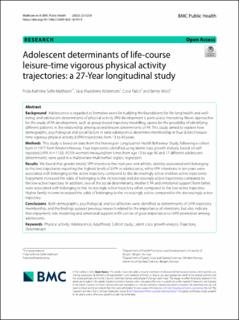| dc.contributor.author | Mathisen, Frida Kathrine Sofie | |
| dc.contributor.author | Kristensen, Sara Madeleine | |
| dc.contributor.author | Falco, Coral | |
| dc.contributor.author | Wold, Bente | |
| dc.date.accessioned | 2023-10-06T07:50:13Z | |
| dc.date.available | 2023-10-06T07:50:13Z | |
| dc.date.created | 2023-08-25T14:47:25Z | |
| dc.date.issued | 2023 | |
| dc.identifier.citation | BMC Public Health. 2023, 23 (1), . | en_US |
| dc.identifier.issn | 1471-2458 | |
| dc.identifier.uri | https://hdl.handle.net/11250/3094732 | |
| dc.description.abstract | Abstract
Background
Adolescence is regarded as formative years for building the foundations for life-long health and well-being, and adolescent determinants of physical activity (PA) development is particularly interesting. Novel approaches for the study of PA development, such as group-based trajectory modelling, opens for the possibility of identifying different patterns in the relationship among several known determinants of PA. This study aimed to explore how demographic, psychological and social factors in early adolescence determine membership in four distinct leisure-time vigorous physical activity (LVPA) trajectories from 13 to 40 years.
Methods
This study is based on data from the Norwegian Longitudinal Health Behaviour Study, following a cohort born in 1977 from Western Norway. Four trajectories identified using latent class growth analysis, based on self-reposted LVPA (n = 1103, 45.5% women) measured ten times from age 13 to age 40 and 17 different adolescent determinants, were used in a multivariate multinomial logistic regression.
Results
We found that gender (male), VPA intentions the next year and athletic identity associated with belonging to the two trajectories reporting the highest levels of LVPA in adolescence, while VPA intentions in ten years were associated with belonging to the active trajectory compared to the decreasingly active and low active trajectories Enjoyment increased the odds of belonging to the increasingly and decreasingly active trajectories compared to the low active trajectory. In addition, two of the social determinants, mother’s PA and emotional support from father, were associated with belonging to the increasingly active trajectory when compared to the low active trajectory. Higher family income increased the odds of belonging to the increasingly active compared to the decreasingly active trajectory.
Conclusions
Both demographic, psychological, and social factors were identified as determinants of LVPA trajectory membership, and the findings support previous research related to the importance of intentions, but also indicate that enjoyment, role modelling and emotional support in PA can be of great importance to LVPA promotion among adolescents. | en_US |
| dc.language.iso | eng | en_US |
| dc.publisher | BioMed Central | en_US |
| dc.rights | Navngivelse 4.0 Internasjonal | * |
| dc.rights.uri | http://creativecommons.org/licenses/by/4.0/deed.no | * |
| dc.title | Adolescent determinants of life-course leisure-time vigorous physical activity trajectories: a 27-Year longitudinal study | en_US |
| dc.type | Peer reviewed | en_US |
| dc.type | Journal article | en_US |
| dc.description.version | publishedVersion | en_US |
| dc.rights.holder | © The Author(s) 2023 | en_US |
| dc.source.pagenumber | 0 | en_US |
| dc.source.volume | 23 | en_US |
| dc.source.journal | BMC Public Health | en_US |
| dc.source.issue | 1 | en_US |
| dc.identifier.doi | 10.1186/s12889-023-16191-9 | |
| dc.identifier.cristin | 2169763 | |
| dc.source.articlenumber | 1258 | en_US |
| cristin.ispublished | true | |
| cristin.fulltext | original | |
| cristin.qualitycode | 1 | |

